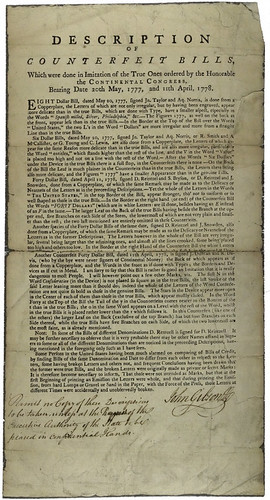
PREV ARTICLE
NEXT ARTICLE
FULL ISSUE
PREV FULL ISSUE
COUNTERFEIT CONTINENTAL CURRENCY BROADSIDE
Another quality product of the American Numismatic Society is Matthew Wittmann's Pocket Change blog. Tuesday's installment
depicts a marvelous 1778/1779 broadside by Philadelphia printer John Dunlap. -Editor
Which were done in Imitation of the True Ones ordered by the Honorable the CONTINENTAL CONGRESS, Bearing Date 20th May, 1777, and 11th April, 1778. The $40 bill was the highest denomination of what are know as the Yorktown notes, since they were authorized by an April 11, 1778 resolution and printed in York, Pennsylvania, where the Continental Congress was temporarily residing. The broadside enumerates three separate fraudulent versions of the $40 note, and it might have been the most counterfeited of the era. The problem was so serious that large numbers of these Yorktown notes were simply destroyed, and this is what makes them the rarest and most expensive notes for collectors today. The fiasco only further depreciated the already shaky Continental Currency, which at this point was worth only between a quarter to a third of its nominal value, i.e. one dollar of silver was worth three or four dollars of paper money. By the end of the war, “not worth a continental” had entered the lexicon for something regarded as worthless. The handwritten annotation at the bottom of the broadside reads: “Permit no copy of these descriptions to be taken unless at the request of the Executive Authority of the State to be placed in confidential hands.” It was also signed by the auditor general of the Continental Congress, John Gibson, for whom counterfeit bills were clearly a pressing issue, but it’s unclear how great of an aid this rather simple but detailed descriptive list was in combating the problem. Still it does offer a fascinating window into the financial schemes that the American colonists relied on to fund the war and the machinations that the British attempted to thwart them.
The article also includes an image of a marvelous 1777advertisement offering Counterfeit notes. -Editor
For British forces and their Loyalist allies, counterfeiting was also seen as a weapon of war, as this infamous advertisement published in a newspaper from British-occupied New York City makes clear. 
The advertisement promised “exactly executed” counterfeit “Congress notes” to any person traveling into the colonies, observing that a large amount had already been circulated and that there was “no Risque in getting them off.” To be fair, there were a variety of opportunists on both sides who were successfully counterfeiting Continental Currency, but British efforts were certainly more organized and systemic. To read the complete article, see:
THE BOOK BAZARREWayne Homren, Editor The Numismatic Bibliomania Society is a non-profit organization promoting numismatic literature. See our web site at coinbooks.org. To submit items for publication in The E-Sylum, write to the Editor at this address: whomren@gmail.com To subscribe go to: https://my.binhost.com/lists/listinfo/esylum All Rights Reserved. NBS Home Page Contact the NBS webmaster 
|
